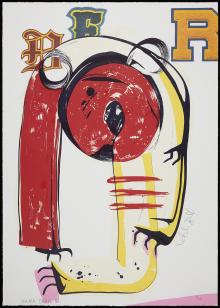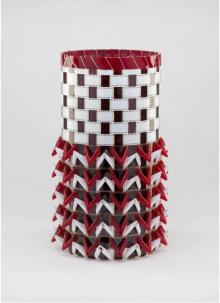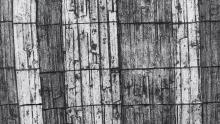Back
2021-22 Common Seeing: Meeting Points
Natalie Ball (American, Black, Modoc, and Klamath, b. 1980). Mama Bear IV, 2020. Five-color lithograph with archival inkjet chine-collé (collaborating printer: Judith Baumann, Crow's Shadow Institute of the Arts), 32-1/2 x 23 in. Museum purchase through the Hartz FUNd for Contemporary Art
Gail Tremblay (American, Mi'kmaq, and Onondaga, b. 1945), 2018. 1981 Film Irony: Trying to Have an American Film in Cheyenne Native Language Judged in the Foreign Film Category for the Oscars (Even the Academy Rejected the Proposal), 2018. 35mm film (from “Windwalker," 1981), red and white film leader, silver braid 24 x 14 x 14 in. Museum Purchase through the Edna Pearl Horton Memorial Endowment. (Image courtesy of the Artist and Froelick Gallery; photography by Mario Gallucci.)
Brenda Mallory (American, Cherokee, b. 1955). Partitioning (detail), 2017. Collagraph prints on kozo paper, thread, wax, 30 x 95 ½ x 3 inches. Courtesy of the Artist. (Photography by Mario Gallucci.)
2021-22 Common Seeing: Meeting Points
October 14, 2021 to April 10, 2022
Every year, the University of Oregon’s Common Reading program encourages campus-wide engagement with a shared book and related resources. JSMA’s corresponding Common Seeing expands this conversation through the visual arts. The 2021-22 selection, Braiding Sweetgrass: Indigenous Wisdom, Scientific Knowledge and the Teachings of Plants by Robin Wall Kimmerer, addresses humanity’s responsibility to the natural world through its author’s observations as an enrolled member of the Citizen Potawatomi Nation, academically trained botanist, and mother. Kimmerer calls for a reciprocal relationship between people and nature that prioritizes generosity and respects the needs of all living things. Her memoir’s interwoven topics include ecology, parenting, Indigenous land and water rights, traditional foodways, good citizenship, sustainability, climate change, and the preservation of language. This year’s Common Seeing brings together works by nine contemporary Native artists that speak to these issues and each’s experiences as individuals and members of their communities. Featured artists include Natalie Ball (American, Black, Modoc and Klamath), Joe Feddersen (Colville Confederated Tribes), Bud Lane (Siletz), Joey Lavadour (Walla Walla/Métis), Brenda Mallory (Cherokee), Lillian Pitt (Warm Springs, Wasco, and Yakama), Gail Tremblay (Mi'kmaq and Onondaga), Kay WalkingStick (Cherokee), and Shirod Younker (Coquille, Coos, and Umpqua, b. 1972). JSMA is especially grateful to the Museum of Natural and Cultural History for lending work from their collection. For more information about the UO’s Common Reading and to find out how members of the UO Community can access a digital copy of Braiding Sweetgrass, visit https://fyp.uoregon.edu/common-reading-2021-2022-braiding-sweetgrass.
The JSMA is located on Kalapuya ilihi, the traditional indigenous homeland of the Kalapuya people. Following treaties between 1851 and 1855, Kalapuya people were dispossessed of their indigenous homeland by the United States government and forcibly removed to the Coast Reservation in Western Oregon. Today, Kalapuya descendants are primarily citizens of the Confederated Tribes of Grand Ronde and the Confederated Tribes of Siletz Indians, and they continue to make important contributions to their communities, to the UO, to Oregon, and to the world. In following the Indigenous protocol of acknowledging the original people of the land we occupy, we also extend our respect to the nine federally recognized Indigenous nations of Oregon: the Burns Paiute Tribe, the Confederated Tribes of the Coos, Lower Umpqua and Siuslaw Indians, the Confederated Tribes of the Grand Ronde, the Confederated Tribes of Siletz Indians, the Confederated Tribes of the Umatilla Indian Reservation, the Confederated Tribes of Warm Springs, the Coquille Indian Tribe, the Cow Creek Band of Umpqua Tribe of Indians, and the Klamath Tribes. We express our respect to the many more tribes who have ancestral connections to this territory, as well as to all other displaced Indigenous peoples who call Oregon home.








